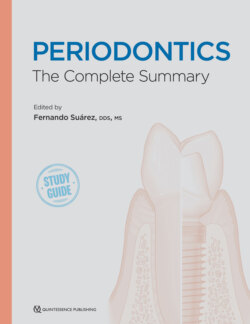Читать книгу Periodontics - Fernando Suarez - Страница 112
OVERHANGING RESTORATIONS
ОглавлениеAn overhanging restoration that occupies the interproximal space might be conducive to periodontal breakdown and alveolar bone destruction.215,216 Studies reporting the prevalence of overhangs are included in Table 5-12.216–218
TABLE 5-12 Prevalence of overhanging restorations
| Authors | Prevalence |
| Gilmore and Sheiman216 | 32% |
| Jeffcoat and Howell217 | 71% |
| Pack et al218 | 56% |
The classic study by Jeffcoat and Howell randomly selected 100 periodontal patients to assess the effect of amalgam overhangs on the alveolar bone height and classified their size into small (< 20%), medium (20%–50%), and large (> 50%) based on the interproximal space occupied by the overhang217 (Table 5-13). The authors showed that only medium and large overhanging restorations revealed significant bone loss when compared with control teeth.
TABLE 5-13 Classification of overhangs by Jeffcoat and Howell217
| Size | Percentage of interproximal space occupied by overhang |
| Small | < 20% |
| Medium | 20%–50% |
| Large | > 50% |
Pack et al evaluated 2,117 restored surfaces and reported that most of the overhangs were associated with pockets greater than 3 mm (64.3%) and bleeding on probing (32%).218 Also, Jansson et al concluded that sites with overhangs were associated with deeper probing depths, radiographic bone loss, and worsened parameters among susceptible periodontal patients.219
Removal of overhangs in combination with plaque elimination results in significant reduction of gingival inflammation,220–222 and it is recommended during the initial phase of periodontal therapy.223
